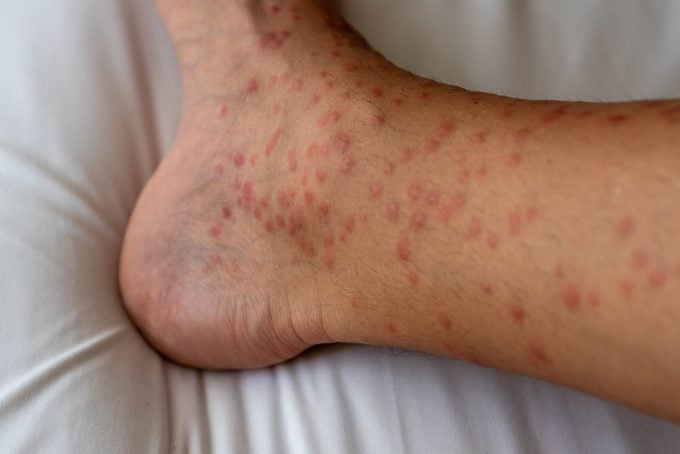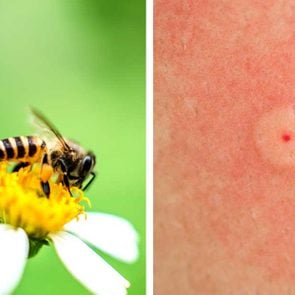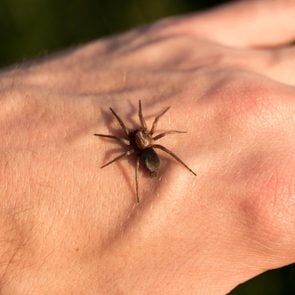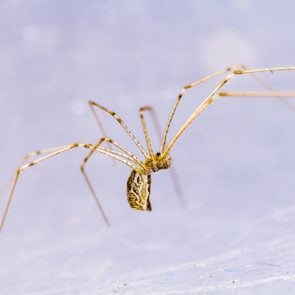Have a Severe Reaction to a Bug Bite? It Could Be Papular Urticaria
Updated: Jul. 12, 2021
Itchy, red bumps with fluid-filled blisters—these are the signs of papular urticaria, an allergic reaction to a bug bite. But you—or your child—shouldn't have to suffer: Check out these tips.
What is papular urticaria?
Nobody likes bug bites, but people with papular urticaria have an especially good reason to hate them.
Papular urticaria is a hypersensitivity to bug bites. The condition causes a bump or red welts on the skin in reaction to an insect bite or sting.
In people with papular urticaria, these bites cause long-lasting, red, raised, itchy bumps to develop on the skin. It can also cause small blisters (called vesicles) to form on the skin, sometimes in clusters.
This condition is common and mainly impacts children, though anyone can develop it at any age.
A 2017 study published in the World Allergy Organization Journal suggests these severe bug bite reactions may affect around 20 percent of children aged one to six. Because much of the research is conducted in children, the prevalence in adults is unclear.
Here’s what you need to know about papular urticaria, including how to identify and treat it.

Symptoms of papular urticaria
People with papular urticaria develop raised, red, hard bumps (called papules) after being bitten by a bug. Typically, each papule has a small tip or raised point.
Papular urticaria can also cause blisters that contain fluid, which might be clear, yellowish, or dark-colored.
Papules and blisters caused by papular urticaria also tend to:
- Appear in clusters
- Range from 0.2 to 2 centimeters in width
- Appear every couple of days during months that bugs are most active and people are outdoors the most (summer and autumn)
- Occur on places with exposed skin, such as the face, neck, forearms, legs, or just above socks or below shorts
- Redevelop when old sores start to heal
- Appear sometimes in tiny clusters or groups over the whole body
- Leave dark spots on the skin after healing
- May impact only one person in a household or family
- Have the potential to open and leak fluid
- Scab as they heal sometimes
In very young children, symptoms may develop very quickly after the child is bitten.
With age, the reaction often takes longer to develop, or becomes delayed. In these cases, it can be nearly impossible to tell where the initial bite occurred and when.
(These are the bug bite symptoms you shouldn’t ignore.)
What causes papular urticaria?
When an insect bites and breaks the skin, it introduces foreign protein into the skin, explains Walter M. Ryan III, DO, an osteopathic doctor and allergist with the Florida Center for Allergy & Asthma Care in Boca Raton and Coral Springs.
Our immune cells do not recognize these foreign proteins, which spark an inflammatory process known as an allergic reaction. The body’s goal: to destroy and remove the unknown proteins.
This inflammatory process is usually triggered by the release of a chemical called histamine from specialized immune cells known as mast cells.
“When histamine is released after insect bites, it makes our skin turn red, activates itch sensation, and often leaves elevated bumps called papules,” says Danilo Del Campo, MD, a dermatologist with the Chicago Skin Clinic.
Most people develop some minor, temporary itchiness, redness, and a bit of swelling from bug bites.
But in people with papular urticaria, regular bug bites cause an exaggerated immune response and symptoms that are more severe and long-lasting.
Researchers believe that papular urticaria is a hypersensitivity, or increased sensitivity, an allergic reaction to bug bites, says Dr. Del Campo.
(These are the bug bites that need medical attention now.)
How long does a reaction/symptoms last?
The bumps and blisters associated with papular urticaria tend to last for days to weeks. In some cases, they may even stick around for several months.
Someone may also continue to develop new clusters or crops of bumps and blisters for months—even years—after the reaction first started.
Thankfully, the reaction tends to lessen over time.
As children grow older, their immune systems gradually become less sensitive to bug bites. So over time, the average child with papular urticaria will react less severely to bug bites, and the reaction will take longer to develop.
While adults can develop papular urticaria, most people become less sensitive to bug bites by age seven.
How is this different from hives?
Hives, or urticaria, are round, red, raised, solid bumps that are very itchy. Press on hives, and they’ll blanch (turn white in the center).
Despite its name, papular urticaria does not cause real hives. “Papular urticaria is not actual urticaria,” says Dr. Ryan.
True hives cause welts or bumps that last for less than 24 hours. Papules and blisters associated with papular urticaria last a matter of days or weeks.
Can all bugs cause papular urticaria reactions?
All biting insects can cause a papular urticaria reaction, but flea and mite bites are the most common triggers.
Other bugs that are known to cause papular urticaria reactions include:
- Mosquitoes
- Black flies
- Horseflies and deerflies
- Sandflies and fleas
- Gnats
- Bed bugs
- Bird mites
- Carpet beetles
- Spiders
- Ticks
- Caterpillars
- Chiggers
How is papular urticaria diagnosed?
A doctor will diagnose someone with papular urticaria by examining their skin and areas with symptoms.
They will also ask questions about:
- Symptoms
- Exposure to bug bites
- History of exposure to bugs or bug bites
- Living environment
- Time and locations spent outdoors
- History of other skin conditions or allergic reactions
A doctor may also take a biopsy—a small sample of affected skin—to examine under a microscope to confirm the diagnosis. Most bug bites create specific microscopic patterns.
Experts say that despite how common it is, papular urticaria can be difficult to diagnose and often goes overlooked.
That’s why it is important to seek care from a skin specialist like a board-certified dermatologist.
“Any MD can diagnose this condition, but board-certified dermatologists are most familiar in diagnosing and treating this condition,” says Dr. Del Campo.
He suggests that people use the American Academy of Dermatology’s Find a Dermatologist tool to location a board-certified doctor nearby.
Treating papular urticaria
Treatment options for papular urticaria tend to focus on reducing the size and itchiness of bumps to relieve symptoms and make someone less likely to scratch and worsen the reaction.
Products or medications may also help prevent infection or keep the skin from drying out and becoming itchier.
“In general, avoiding scratching at the bumps, getting relief from itching, and avoiding further insect bites are the key factors in management,” says Dr. Del Campo. “Dermatologists often prescribe a topical medication to assist in relieving symptoms since chronic itching can lead to skin infections, broken-down skin, and impaired sleep due to itching.”
The best treatment, or combination of treatments, depends largely on how severe someone’s symptoms are. But some common treatment options for papular urticaria include:
Topical steroids
These creams or ointments contain compounds, such as hydrocortisone, that reduce inflammation. They may also make symptoms go away quicker.
Apply topical steroids to affected areas of skin as soon as symptoms develop. You can get them in over-the-counter strengths, or by prescription.
Antihistamine tablets
These medications prevent the release of histamine when taken daily. They’re often taken to reduce existing symptoms or as a preventative measure during times of the year symptoms tend to occur.
Most antihistamines are available over the counter, though stronger prescription versions exist.
Antiseptic creams
These creams contain compounds that kill microorganisms such as bacteria and fungi that can cause infection.
Microorganisms can enter the skin through tears or cuts or when someone scratches their skin with their fingernails.
Antiseptic creams are readily available over the counter but can come in prescription strength.
Unscented, gentle moisturizers
Applying moisturizing creams, gels, or ointments to impacted areas of the skin a few times daily, especially after bathing, can help reduce dryness and itchiness.
Moisturizers are available over the counter or in prescription strength.
Topical anti-itch or pain-relieving creams
Certain creams, gels, ointments, or other formulas contain compounds that prevent itchiness by temporarily cooling or numbing the skin. One such soothing treatment is calamine lotion.
Dr. Ryan suggests using anti-itch products with menthol, camphor, or pramoxine.
Some pain-relieving products may also create a sensation such as warmth, cooling, or slight burning to distract someone from itchiness.
Most of these products are available over the counter. Do not apply anti-itch or pain-relieving creams to broken skin or open sores.
Sunscreen
Bumps and blisters caused by papular urticaria can leave behind dark spots on the skin once they heal.
Keeping these areas covered with sunscreen whenever they are in the sun will help these dark spots heal and fade quicker.
Make sure to use unscented sunscreen; those with heavy scents can attract bugs.
(Here are more ways to treat common types of bug bites and stings.)
Lifestyle tips
Experts claim there is really only one way to prevent papular urticaria: prevent bug bites.
This may be easier said than done, especially for those who love the outdoors. But there are plenty of ways to reduce the likelihood of getting a bug bite.
Before going outside
Use insect repellant sprays or lotions when outdoors. Look for products with the insecticide DEET, a bug-killing chemical. Or try other bug-repelling products.
Remember to wear long-sleeved shirts, socks, and full-length pants in areas where bugs are very active. Tuck your pant legs into socks and closed-toed shoes or boots.
Avoid spending time outdoors during times of the day when bugs are especially active, such as dawn and dust. If you do go outside during peak times, wear protective equipment, such as a hat with mosquito netting.
Lastly, be sure to avoid areas with standing water, such as marshes, ponds, and other wetland environments.
While outside and afterward
Stay on cleared paths or trails when hiking or going for a walk. Avoid going around places bugs are most active or looking to attach to clothing or skin, such as around trees, flowers, shrubs, bushes, wood or leaf piles, or tall grass.
Be sure to avoid going in the deep woods in the warmer months of the year.
When outside, try not to brush up against plants.
If bugs come near or swarm around you, remain calm. Walk away from them to prevent scaring them and increasing the risk they will bite or sting.
Keep an eye out for—and avoid—bug nests, mounds, or hives.
Lastly, make sure you check clothes, footwear, and equipment for bugs before bringing them into the house.
Check the whole body for bug or bug bites after being outdoors. In particular, look in places like the backs of your knees, around your waist, in your hair, in your armpits, and between your legs.
Other tips for preventing bug bites
At home, regularly check bedding, carpets, and other fabric surfaces or wood furniture for bugs or signs of bugs, like biting or chewing marks, burrowing holes, or feces and dead skins/shells.
Treat household pets for fleas and mites using solutions applied to the animal’s skin, sprayed on its fur, or in the form of a collar. Treat household pets for ticks and other parasites if they go outdoors.
For pets with bug infestations, be sure to seek veterinary care.
If you’re treating minor bug infestations, use household insecticides. Be sure to get an exterminator service to handle more severe infestations.
When at home, use screens on windows and doors, and keep household doors and windows shut if they are not screened. Watch for signs of biting insects like bed bugs to catch potential infestations as soon as possible.
Also, try to avoid eating and drinking outside in areas where bugs are common. Food can attract bugs to you even more.
Following the above tips and tricks can help you lessen your chances of getting bug bites.
Next, learn about the “harmless” bugs you didn’t know could bite you.























